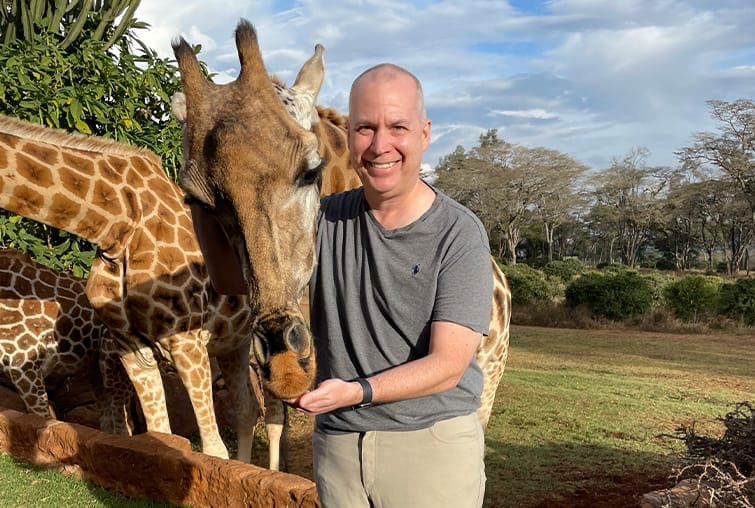Serengeti National Park
The Serengeti National Park is the largest and best known of all the Tanzania National Parks covering an area of 14,500 sq km (5,600 sq miles). Its northern boundary abuts the Maasai Mara National Reserve which is included in the Serengeti eco-system. Located to the north and west of Ngorongoro , the vast Serengeti plains sustain the greatest and most spectacular concentration of wildlife found anywhere in the world.
Most of the Serengeti is vast open plains with lofty rocky outcrops giving character to the landscape. There are also acacia and savannah woodland and scrub, forested and well-treed rivers, and the occasional swamp and small lake. The granite outcrops formed many millions of years ago and through the passage of time have become exposed and broken to form the rocky outcrops.
During February and March the vast herds of wildebeest and zebra gather to the south to give birth, it is estimated 400,000 wildebeest calves are born within a six week period. This mass birthing phenomenon takes place when water and fresh grazing is plentiful and helps to reduce infant mortality from predation. The animals then move north along the western corridor to the Maasai Mara to breed before moving south to start the whole pattern all over again.
The Serengeti is also known for its large prides of lions and the magnificent black maned lions are often seen surveying their territories from the top of the rocky outcrops. Leopards are relatively numerous and are to be found during the daytime resting in trees along the Seronera river.
Little creatures also play an important role in the plains life cycle. Banded mongoose, brightly coloured agama lizards, rock hyrax, dikdik, vervet monkeys to name just a few of the smaller animals all of which add to the wildlife spectacle of the Serengeti.
Large numbers of Kori Bustard, Africa’s heaviest flying birds, as well as the snake eating Secretary Bird, Crowned Plover, Yellow throated sandgrouse to name just a few of the many birds to be found on the plains.
Most of the Serengeti is vast open plains with lofty rocky outcrops giving character to the landscape. There are also acacia and savannah woodland and scrub, forested and well-treed rivers, and the occasional swamp and small lake. The granite outcrops formed many millions of years ago and through the passage of time have become exposed and broken to form the rocky outcrops.
During February and March the vast herds of wildebeest and zebra gather to the south to give birth, it is estimated 400,000 wildebeest calves are born within a six week period. This mass birthing phenomenon takes place when water and fresh grazing is plentiful and helps to reduce infant mortality from predation. The animals then move north along the western corridor to the Maasai Mara to breed before moving south to start the whole pattern all over again.
The Serengeti is also known for its large prides of lions and the magnificent black maned lions are often seen surveying their territories from the top of the rocky outcrops. Leopards are relatively numerous and are to be found during the daytime resting in trees along the Seronera river.
Little creatures also play an important role in the plains life cycle. Banded mongoose, brightly coloured agama lizards, rock hyrax, dikdik, vervet monkeys to name just a few of the smaller animals all of which add to the wildlife spectacle of the Serengeti.
Large numbers of Kori Bustard, Africa’s heaviest flying birds, as well as the snake eating Secretary Bird, Crowned Plover, Yellow throated sandgrouse to name just a few of the many birds to be found on the plains.
Serengeti National Park Accommodation
Talk to a Specialist
Choose a Safari Specialist in your time zone and start planning your tailor-made safari to Tanzania.

Julie Roggow
Julie Roggow
Greetings, I'm Julie Roggow, and I come to you with over two decades of immersion in the world of travel. My journey into the heart of safari adventures began as I traversed Kenya, Uganda, Tanzania, Rwanda, Botswana, Zimbabwe, and South Africa, capturing the essence of these mesmerizing landscapes through my lens. Among these remarkable destinations, Kenya and the Porini safari camps hold a special place in my heart. Their unique blend of wilderness and conservation resonates deeply with me.
My passion for travel is matched only by my dedication to sharing that passion with others. I'm here to ensure that planning your safari vacation is an enjoyable and seamless experience.
Feel free to reach out to me by email at julie@gamewatchers.com or through our toll-free telephone line at +1-877-710-3014.
Rick McIntyre
Hello, I'm Rick, based in Ontario, Canada, with over 15 years in the travel industry and a passport filled with stamps from over 70 countries. My heart was captured by Africa during my first visit to Kenya, and since then, I've journeyed back repeatedly, exploring the diverse landscapes and wildlife of Kenya, Tanzania, Rwanda, Zambia, Zimbabwe, Botswana, Namibia, and South Africa. Whether you're dreaming of a "once in a lifetime" vacation or you're a seasoned safari traveler, I'm here to assist in planning your perfect African adventure.
You can contact me at rick@gamewatchers.com or give me a call at +1-877-710-3014.

Rachel Chambers
Rachel Chambers
Hi, I’m Rae, based on the West Coast of Canada, on beautiful Vancouver Island. I’m a passionate traveler who has explored nearly 30 countries, but it was a solo journey to Africa that truly transformed my perspective. From the moment I arrived in Botswana, I felt an undeniable connection to the continent and was inspired to spend more time experiencing its extraordinary wildlife, breathtaking landscapes, and rich cultures. My solo travels have since taken me through Zimbabwe, Zambia, Mauritius, South Africa, Uganda, Namibia, and Kenya, where I experienced Gamewatchers Safaris and Porini Camps firsthand. It was during these immersive and unforgettable journeys that my passion for Africa evolved into a clear vision: to join the Gamewatchers team and help others discover the magic of safari. I’d love to connect and plan your wildest dreams!
You can contact me at rae@gamewatchers.com

Julie Roggow
Julie Roggow
Greetings, I'm Julie Roggow, and I come to you with over two decades of immersion in the world of travel. My journey into the heart of safari adventures began as I traversed Kenya, Uganda, Tanzania, Rwanda, Botswana, Zimbabwe, and South Africa, capturing the essence of these mesmerizing landscapes through my lens. Among these remarkable destinations, Kenya and the Porini safari camps hold a special place in my heart. Their unique blend of wilderness and conservation resonates deeply with me.
My passion for travel is matched only by my dedication to sharing that passion with others. I'm here to ensure that planning your safari vacation is an enjoyable and seamless experience.
Feel free to reach out to me by email at julie@gamewatchers.com or through our toll-free telephone line at +1-877-710-3014.
Rick McIntyre
Hello, I'm Rick, based in Ontario, Canada, with over 15 years in the travel industry and a passport filled with stamps from over 70 countries. My heart was captured by Africa during my first visit to Kenya, and since then, I've journeyed back repeatedly, exploring the diverse landscapes and wildlife of Kenya, Tanzania, Rwanda, Zambia, Zimbabwe, Botswana, Namibia, and South Africa. Whether you're dreaming of a "once in a lifetime" vacation or you're a seasoned safari traveler, I'm here to assist in planning your perfect African adventure.
You can contact me at rick@gamewatchers.com or give me a call at +1-877-710-3014.

Rachel Chambers
Rachel Chambers
Hi, I’m Rae, based on the West Coast of Canada, on beautiful Vancouver Island. I’m a passionate traveler who has explored nearly 30 countries, but it was a solo journey to Africa that truly transformed my perspective. From the moment I arrived in Botswana, I felt an undeniable connection to the continent and was inspired to spend more time experiencing its extraordinary wildlife, breathtaking landscapes, and rich cultures. My solo travels have since taken me through Zimbabwe, Zambia, Mauritius, South Africa, Uganda, Namibia, and Kenya, where I experienced Gamewatchers Safaris and Porini Camps firsthand. It was during these immersive and unforgettable journeys that my passion for Africa evolved into a clear vision: to join the Gamewatchers team and help others discover the magic of safari. I’d love to connect and plan your wildest dreams!
You can contact me at rae@gamewatchers.com

Julie Roggow
Julie Roggow
Greetings, I'm Julie Roggow, and I come to you with over two decades of immersion in the world of travel. My journey into the heart of safari adventures began as I traversed Kenya, Uganda, Tanzania, Rwanda, Botswana, Zimbabwe, and South Africa, capturing the essence of these mesmerizing landscapes through my lens. Among these remarkable destinations, Kenya and the Porini safari camps hold a special place in my heart. Their unique blend of wilderness and conservation resonates deeply with me.
My passion for travel is matched only by my dedication to sharing that passion with others. I'm here to ensure that planning your safari vacation is an enjoyable and seamless experience.
Feel free to reach out to me by email at julie@gamewatchers.com or through our toll-free telephone line at +1-877-710-3014.
- 1
- 2
- 3

Wayne Hammond
Wayne Hammond
Hello, I'm Wayne Hammond, and I'm fortunate to have embarked on over 30 incredible journeys to the enchanting continent of Africa. It's a place that has captured my heart time and time again. My travels have taken me to Kenya, which I've had the pleasure of visiting far more times than I can recall, as well as to Tanzania, Zimbabwe, Zambia, Botswana, Rwanda, Uganda, South Africa, and Mozambique. Among my cherished bush haunts, I hold dear the Masai Mara in Kenya, the mesmerizing Mana Pools in Zimbabwe, and the wondrous South Luangwa National Park in Zambia. I'm not just a passionate traveler but also an avid amateur wildlife photographer and an occasional travel writer.
If you're ready to embark on your own African adventure, don't hesitate to reach out to me at wayne@gamewatchers.com or give me a call at +44 7986 978 985.
Andrea Landaeta
Hola, I’m Andrea and my love affair with the captivating world of safaris began during my teenage years when I embarked on my very first safari in Kenya. There, amidst the awe-inspiring wildlife and expansive plains, I found my true passion. Over the years, Kenya has called me back time and time again, leading me to explore its myriad camps, conservancies, and renowned parks. More recently, I've had the privilege of staying at all the Porini Camps, where the spotlight shines on wildlife conservation—a cause close to my heart as I traverse the globe. While Kenya holds a special place in my wanderlust-filled heart, Tanzania, Uganda, and Rwanda have also woven their magic into my soul. If you're eager to embark on your own safari adventure or share your passion for conservation, please feel free to contact me at andrea@gamewatchers.com
Let's connect and embark on a journey through Africa's wild wonders together.
Pranay Chandra
Hello, I’m Pranay Chandra, a veteran of the Indian Armed Forces whose profound passion for nature and wildlife led me to the world of wildlife photography. My lens has captured the essence of the wild, earning recognition in esteemed competitions like the Sanctuary Asia annual wildlife awards and the Natural History Museum’s Wildlife Photographer of the Year awards. Beyond photography, I’ve dedicated myself to conservation efforts, collaborating with Ecological Task Forces and supporting WWF India’s training initiatives in tiger reserves. In the realm of education, I’ve partnered with CEC, New Delhi, to create informative video programs on Human-Wildlife Conflicts. I’ve ventured to Kenya, embracing the splendours of Africa while staying at Porini camps and other renowned lodges.
You can connect with me via email at pranay@gamewatchers.com or by phone at +91 801 788 5256
Form Off Contact Specialist Box
Talk to a Specialist
Choose a Safari Specialist in your time zone and start planning your tailor-made safari to Kenya.







Hola, I’m Andrea and my love affair with the captivating world of safaris began during my teenage years when I embarked on my very first safari in Kenya. There, amidst the awe-inspiring wildlife and expansive plains, I found my true passion. Over the years, Kenya has called me back time and time again, leading me to explore its myriad camps, conservancies, and renowned parks. More recently, I’ve had the privilege of staying at all the Porini Camps, where the spotlight shines on wildlife conservation—a cause close to my heart as I traverse the globe. While Kenya holds a special place in my wanderlust-filled heart, Tanzania, Uganda, and Rwanda have also woven their magic into my soul. If you’re eager to embark on your own safari adventure or share your passion for conservation, please feel free to contact me at andrea@gamewatchers.com
Let’s connect and embark on a journey through Africa’s wild wonders together.
Andrea Landaeta

Hello, I’m Pranay Chandra, a veteran of the Indian Armed Forces whose profound passion for nature and wildlife led me to the world of wildlife photography. My lens has captured the essence of the wild, earning recognition in esteemed competitions like the Sanctuary Asia annual wildlife awards and the Natural History Museum’s Wildlife Photographer of the Year awards. Beyond photography, I’ve dedicated myself to conservation efforts, collaborating with Ecological Task Forces and supporting WWF India’s training initiatives in tiger reserves. In the realm of education, I’ve partnered with CEC, New Delhi, to create informative video programs on Human-Wildlife Conflicts. I’ve ventured to Kenya, embracing the splendors of Africa while staying at Porini camps and other renowned lodges. I’m based in Bangalore, India, and you can connect with me via email at pranay@gamewatchers.com or reach me by phone at +91 801 788 5256, including WhatsApp. Let’s embark on a journey to celebrate the beauty and conservation of our natural world together.
Pranay Chandra

Hello, I’m Kristy, your Australian-based Safari Advisor with Gamewatchers Safaris and Porini Camps. My background in ecology and conservation management, combined with a deep passion for nature and the great outdoors, led me to Kenya where I instantly fell in love with its spectacular wildlife and warm-hearted people. Having spent significant time at our Porini Camps and explored other camps we offer, I bring intricate knowledge to help craft your ultimate wildlife safari adventure. Whether you’re seeking the thrill of the savannah or the serenity of the wilderness, I’m here to make your safari dreams a reality.
Feel free to reach out to me on the Gold Coast, Australia, at kristy@gamewatchers.com or call +61 419 175 672
Kristy Thomson







































